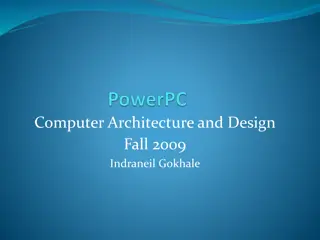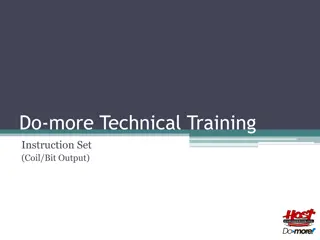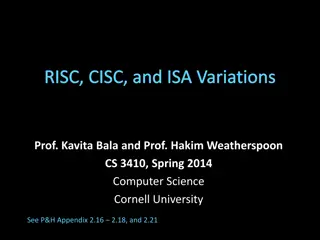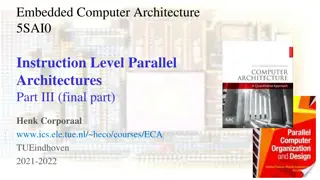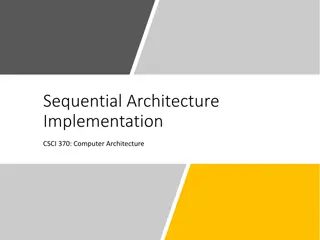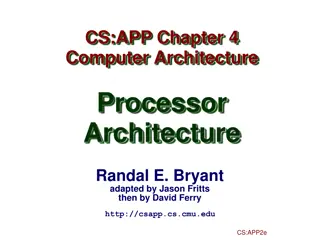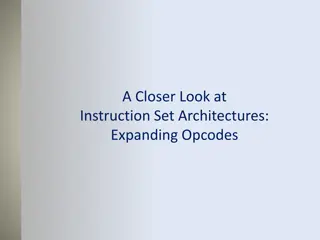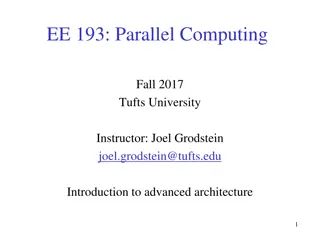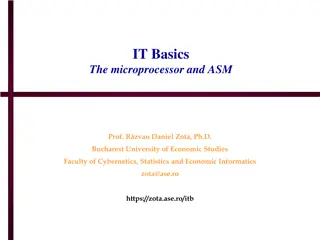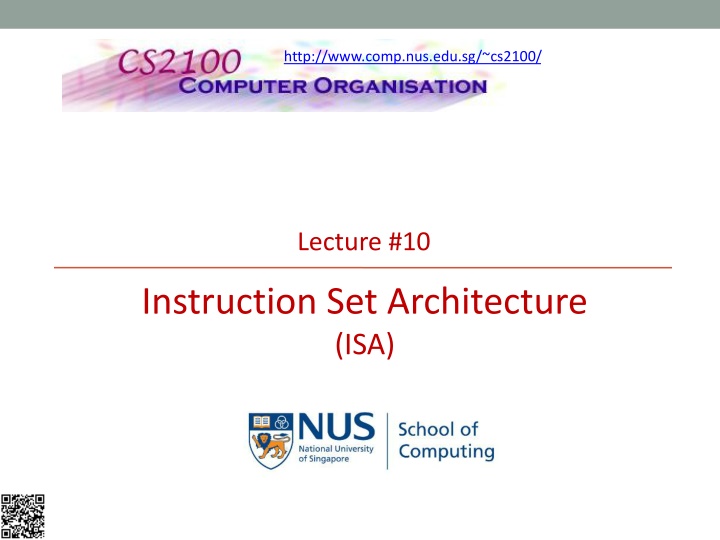
Lecture #10: Instruction Set Architecture Overview
The concepts of Data Storage, Memory Addressing Modes, Operations, Instruction Formats, and Encoding in Instruction Set Architecture. Learn about the battle between RISC and CISC design philosophies, with examples like MIPS and x86-32. Dive into the design of ISA, beyond just studying MIPS, and consider alternative assembly languages.
Download Presentation

Please find below an Image/Link to download the presentation.
The content on the website is provided AS IS for your information and personal use only. It may not be sold, licensed, or shared on other websites without obtaining consent from the author. If you encounter any issues during the download, it is possible that the publisher has removed the file from their server.
You are allowed to download the files provided on this website for personal or commercial use, subject to the condition that they are used lawfully. All files are the property of their respective owners.
The content on the website is provided AS IS for your information and personal use only. It may not be sold, licensed, or shared on other websites without obtaining consent from the author.
E N D
Presentation Transcript
http://www.comp.nus.edu.sg/~cs2100/ Lecture #10 Instruction Set Architecture (ISA)
Questions? Ask at https://sets.netlify.app/module/676ca3a07d7f5ffc1741dc65 OR Scan and ask your questions here! (May be obscured in some slides)
Aaron Tan, NUS Lecture #10: Instruction Set Architecture 3 Lecture #10: Instruction Set Architecture 1. Overview 2. RISC vs CISC: The Famous Battle 3. The 5 Concepts in ISA Design 3.1 Concept #1: Data Storage 3.2 Concept #2: Memory and Addressing Mode 3.3 Concept #3: Operations in Instruction Set 3.4 Concept #4: Instruction Formats 3.5 Concept #5: Encoding the Instruction Set
Aaron Tan, NUS Lecture #10: Instruction Set Architecture 4 1. Overview We have studied MIPS but it is only one example There are many other assembly languages with different characteristics This lecture gives a more general view on the design of Instruction Set Architecture (ISA) Use your understanding of MIPS and explore other possibilities/alternatives
Aaron Tan, NUS Lecture #10: Instruction Set Architecture 5 2. RISC vs CISC: The Famous Battle Two major design philosophies for ISA: Complex Instruction Set Computer (CISC) Example: x86-32 (IA32) Single instruction performs complex operation VAX architecture had an instruction to multiply polynomials Smaller program size as memory was premium Complex implementation, no room for hardware optimization Reduced Instruction Set Computer (RISC) Example: MIPS, ARM Keep the instruction set small and simple, makes it easier to build/optimise hardware Burden on software to combine simpler operations to implement high-level language statements
Aaron Tan, NUS Lecture #10: Instruction Set Architecture 6 3. The 5 Concepts in ISA Design 1. Data Storage 2. Memory Addressing Modes 3. Operations in the Instruction Set 4. Instruction Formats 5. Encoding the Instruction Set
Aaron Tan, NUS Lecture #10: Instruction Set Architecture 7 3.1 Concept #1: Data Storage Storage Architecture General Purpose Register Architecture Concept #1: Data Storage Concept #2: Memory Addressing Modes Concept #3: Operations in the Instruction Set Concept #4: Instruction Formats Concept #5: Encoding the Instruction Set
Aaron Tan, NUS Lecture #10: Instruction Set Architecture 8 3.1 Storage Architecture: Definition C = A + B Operands may be implicit or explicit. operator operands von Neumann Architecture: Data (operands) are stored in memory For a processor, storage architecture concerns with: Where do we store the operands so that the computation can be performed? Where do we store the computation result afterwards? How do we specify the operands? Major storage architectures (next slide)
Aaron Tan, NUS Lecture #10: Instruction Set Architecture 9 3.1 Storage Architecture: Common Design Stack architecture: Operands are implicitly on top of the stack. Accumulator architecture: One operand is implicitly in the accumulator (a special register). Examples: IBM 701, DEC PDP-8. General-purpose register architecture: Only explicit operands. Register-memory architecture (one operand in memory). Examples: Motorola 68000, Intel 80386. Register-register (or load-store) architecture. Examples: MIPS, DEC Alpha. Memory-memory architecture: All operands in memory. Example: DEC VAX.
Aaron Tan, NUS Lecture #10: Instruction Set Architecture 10 3.1 Storage Architecture: Example Stack Accumulator Register (load-store) Memory-Memory Push A Push B Add Pop C Load A Add B Store C Load R1,A Load R2,B Add R3,R1,R2 Store R3,C Add C, A, B Stack Accumulator Register-register/load-store Memory-Memory C = A+B
Aaron Tan, NUS Lecture #10: Instruction Set Architecture 11 3.1 Storage Architecture: Animation Stack Accumulator Register (load-store) Memory-Memory Push A Push B Add Pop C Load A Add B Store C Load R1,A Load R2,B Add R3,R1,R2 Store R3,C Add C, A, B Push A Push B Add Pop C ... ... 10 20 ? ... A B C 20 10 30 30 ... Stack Memory Variable Name This is information remembered by the compiler.
Aaron Tan, NUS Lecture #10: Instruction Set Architecture 12 3.1 Storage Architecture: Animation Stack Accumulator Register (load-store) Memory-Memory Push A Push B Add Pop C Load A Add B Store C Load R1,A Load R2,B Add R3,R1,R2 Store R3,C Add C, A, B Load A Add B Store C ... ... 10 20 ? ... A B C 30 ? 10 30 ... Accumulator This is a special register! Memory Variable Name This is information remembered by the compiler.
Aaron Tan, NUS Lecture #10: Instruction Set Architecture 13 3.1 Storage Architecture: Animation Stack Accumulator Register (load-store) Memory-Memory Push A Push B Add Pop C Load A Add B Store C Load R1,A Load R2,B Add R3,R1,R2 Store R3,C Add C, A, B Load R1,A Load R2,B Add R3,R1,R2 Store R3,C ... ? ? ? 30 ... ... ... 10 20 10 20 ? ... A B C R1 R2 30 R3 ... ... ... Registers These are general purpose registers Memory Variable Name This is information remembered by the compiler.
Aaron Tan, NUS Lecture #10: Instruction Set Architecture 14 3.1 Storage Architecture: Animation Stack Accumulator Register (load-store) Memory-Memory Push A Push B Add Pop C Load A Add B Store C Load R1,A Load R2,B Add R3,R1,R2 Store R3,C Add C, A, B Add C, A, B ... ... 10 20 ? ... A B C 30 ... Memory Variable Name This is information remembered by the compiler.
Aaron Tan, NUS Lecture #10: Instruction Set Architecture 15 3.1 Storage Architecture: GPR Architecture For modern processors: General-Purpose Register (GPR) is the most common choice for storage design RISC computers typically use Register-Register (Load/Store) design E.g. MIPS, ARM CISC computers use a mixture of Register-Register and Register- Memory E.g. IA32
Aaron Tan, NUS Lecture #10: Instruction Set Architecture 16 3.2 Concept #2: Memory Addressing Mode Memory Locations and Addresses Addressing Modes Concept #1: Data Storage Concept #2: Memory Addressing Modes Concept #3: Operations in the Instruction Set Concept #4: Instruction Formats Concept #5: Encoding the Instruction Set
Aaron Tan, NUS Lecture #10: Instruction Set Architecture 17 3.2 Memory Address and Content Given k-bit address, the address space is of size 2k Each memory transfer consists of one word of n bits Address Processor Memory Up to 2k addressable locations. 0 1 2 3 4 5 Memory Address Register k-bit address bus Memory Data Register n-bit data bus : Control lines (R/W, etc.)
Aaron Tan, NUS Lecture #10: Instruction Set Architecture 18 3.2 Memory Content: Endianness Endianness: The relative ordering of the bytes in a multiple-byte word stored in memory Big-endian: Little-endian: Most significant byte stored in lowest address. Example: IBM 360/370, Motorola 68000, MIPS (Silicon Graphics), SPARC. Least significant byte stored in lowest address. Example: Intel 80x86, DEC VAX, DEC Alpha. Example: 0xDE AD BE EF Stored as: 0 1 2 3 Example: 0xDE AD BE EF Stored as: 0 1 2 3 DE AD BE EF EF BE AD DE NOTE: The endian-ness of MIPS is actually implementation specific.
Aaron Tan, NUS Lecture #10: Instruction Set Architecture 19 3.2 Memory Content: Endianness Endianness: The online MIPS interpreter uses little-endian
Aaron Tan, NUS Lecture #10: Instruction Set Architecture 20 3.2 Addressing Modes Addressing Mode: Ways to specify an operand in an assembly language In MIPS, there are only 3 addressing modes: Register: Operand is in a register (eg: add $t1, $t2, $t3) Immediate: Operand is specified in the instruction directly (eg: addi $t1, $t2, 98) Displacement: Operand is in memory with address calculated as Base + Offset (eg: lw $t1, 20($t2))
Aaron Tan, NUS Lecture #10: Instruction Set Architecture 21 3.2 Addressing Modes: Others Addressing mode Example Meaning Add R4,R3 R4 R4+R3 Register Add R4,#3 R4 R4+3 Immediate Add R4,100(R1) R4 R4+Mem[100+R1] Displacement Add R4,(R1) R4 R4+Mem[R1] Register indirect Add R3,(R1+R2) R3 R3+Mem[R1+R2] Indexed / Base Direct or absolute Add R1,(1001) R1 R1+Mem[1001] Add R1,@(R3) R1 R1+Mem[Mem[R3]] Memory indirect Add R1,(R2)+ R1 R1+Mem[R2]; R2 R2+d Auto-increment Add R1, (R2) R2 R2-d; R1 R1+Mem[R2] Auto-decrement Add R1,100(R2)[R3] R1 R1+Mem[100+R2+R3*d] Scaled
Aaron Tan, NUS Lecture #10: Instruction Set Architecture 22 3.3 Concept #3: Operations in Instructions Set Standard Operations in an Instruction Set Frequently Used Instructions Concept #1: Data Storage Concept #2: Memory Addressing Modes Concept #3: Operations in the Instruction Set Concept #4: Instruction Formats Concept #5: Encoding the Instruction Set
Aaron Tan, NUS Lecture #10: Instruction Set Architecture 23 3.3 Standard Operations Data Movement load (from memory) store (to memory) memory-to-memory move register-to-register move input (from I/O device) output (to I/O device) push, pop (to/from stack) Arithmetic integer (binary + decimal) or FP add, subtract, multiply, divide Shift shift left/right, rotate left/right Logical Control flow Subroutine Linkage Interrupt Synchronisation String Graphics not, and, or, set, clear Jump (unconditional), Branch (conditional) call, return trap, return test & set (atomic r-m-w) search, move, compare pixel and vertex operations, compression/decompression NOTE: Synchronisation is used for multi-thread or multi- core operations. Graphics now common in x86 (e.g., intel iris, etc).
Aaron Tan, NUS Lecture #10: Instruction Set Architecture 24 3.3 Frequently Used Instructions Make these instructions fast! Amdahl s law make the common cases fast! Rank 1 2 3 4 5 6 7 8 9 10 Integer Instructions Load Conditional Branch Compare Store Add Bitwise AND Sub Move register to register Procedure call Return Average % 22% 20% 16% 12% 8% 6% 5% 4% 1% 1% 96% NOTE: To briefly see the benefit, consider that we managed to decrease the time needed to compute the first 4 operations by 50% (i.e., time slashed by 2) at the expense that the rest are slower (e.g., time increase by 50%). Then if the total time originally: T = (0.7 * t) + (0.3 * t) After the improvement, the total time will be: T = (0.35 * t) + (0.45 t) T = (0.80 * t) Which is still an improvement. Total In practice, typically there is no (or only slight) increase in the rest when improvement to some. we made
Aaron Tan, NUS Lecture #10: Instruction Set Architecture 25 3.4 Concept #4: Instruction Formats Instruction Length Instruction Fields Type and Size of Operands Concept #1: Data Storage Concept #2: Memory Addressing Modes Concept #3: Operations in the Instruction Set Concept #4: Instruction Formats Concept #5: Encoding the Instruction Set
Aaron Tan, NUS Lecture #10: Instruction Set Architecture 26 3.4 Instruction Length Variable-length instructions. Intel 80x86: Instructions vary from 1 to 17 bytes long. Digital VAX: Instructions vary from 1 to 54 bytes long. Require multi-step fetch and decode. Allow for a more flexible (but complex) and compact instruction set. Fixed-length instructions. Used in most RISC (Reduced Instruction Set Computers) MIPS, PowerPC: Instructions are 4 bytes long. Allow for easy fetch and decode. Simplify pipelining and parallelism. Instruction bits are scarce. Hybrid instructions: a mix of variable- and fixed-length instructions.
Aaron Tan, NUS Lecture #10: Instruction Set Architecture 27 3.4 Instruction Fields An instruction consists of opcode: unique code to specify the desired operation operands: zero or more additional information needed for the operation The operation designates the type and size of the operands Typical type and size: Character (8 bits), half-word (eg: 16 bits), word (eg: 32 bits), single-precision floating point (eg: 1 word), double-precision floating point (eg: 2 words). Expectations from any new 32-bit architecture: Support for 8-, 16- and 32-bit integer and 32-bit and 64-bit floating point operations. A 64-bit architecture would need to support 64- bit integers as well.
Aaron Tan, NUS Lecture #10: Instruction Set Architecture 28 3.5 Concept #5: Encoding the Instruction Set Instruction Encoding Encoding for Fixed-Length Instructions Concept #1: Data Storage Concept #2: Memory Addressing Modes Concept #3: Operations in the Instruction Set Concept #4: Instruction Formats Concept #5: Encoding the Instruction Set
Aaron Tan, NUS Lecture #10: Instruction Set Architecture 29 3.5 Instruction Encoding: Overview How are instructions represented in binary format for execution by the processor? Issues: Code size, speed/performance, design complexity. Things to be decided: Number of registers Number of addressing modes Number of operands in an instruction The different competing forces: Have many registers and addressing modes Reduce code size Have instruction length that is easy to handle (fixed-length instructions are easier to handle)
Aaron Tan, NUS Lecture #10: Instruction Set Architecture 30 3.5 Encoding Choices Three encoding choices: variable, fixed, hybrid.
Aaron Tan, NUS Lecture #10: Instruction Set Architecture 31 3.5 Fixed Length Instructions: Encoding (1/4) Fixed length instruction presents a much more interesting challenge: Q: How to fit multiple sets of instruction types into same (limited) number of bits? A: Work with the most constrained instruction types first Expanding Opcode scheme: The opcode has variable lengths for different instructions. A good way to maximize the instruction bits.
Aaron Tan, NUS Lecture #10: Instruction Set Architecture 32 3.5 Fixed Length Instructions: Encoding (2/4) Example: 16-bit fixed length instructions, with 2 types of instructions Type-A: 2 operands, each operand is 5-bit Type-B: 1 operand of 5-bit Problem: Wasted bits in Type-B instructions Maximum total number of instructions is 26 or 64. First Attempt: Fixed length Opcode opcode operand operand Type-A 6 bits 5 bits 5 bits opcode operand unused Type-B 6 bits 5 bits 5 bits NOTE: The opcode must be shared between type-A and type-B (e.g., 1 type-A and the rest are type-B; 1 type-B and the rest are type-A; or anything in between). 26 is then simply ignore the unused bits.
Aaron Tan, NUS Lecture #10: Instruction Set Architecture 33 3.5 Fixed Length Instructions: Encoding (3/4) Use expanding opcode scheme: Extend the opcode for type-B instructions to 11 bits No wasted bits and result in a larger instruction set opcode operand operand Second Attempt: Expanding Opcode Type-A 6 bits 5 bits 5 bits opcode operand Type-B 11 bits 5 bits Questions: How do we distinguish between Type-A and Type-B? How many different instructions do we really have? Possible Answers: 1. Think about MIPS, we simply set the opcode as all 0 for R-format but use the "extended opcode" called funct to distinguish. 2. There are different ways to compute the many different instructions depending on what to maximise and/or minimise.
Aaron Tan, NUS Lecture #10: Instruction Set Architecture 34 3.5 Fixed Length Instructions: Encoding (4/4) What is the maximum number of instructions? Answer: 1 + (26 1) 25 = 1 + 63 32 = 2017 opcode operand operand Type-A 6 bits 5 bits 5 bits opcode operand Type-B 11 bits 5 bits Reasoning: 1. For every 6-bit prefix (front-part) given to Type-B, we get 25 unique patterns, e.g. [111111]XXXXX 2. So, we should minimise Type-A instruction and give as many 6-bit prefixes as possible to Type-B 1 Type-A instruction, 26 1 prefixes for Type-B
Aaron Tan, NUS Lecture #10: Instruction Set Architecture 35 3.5 Extended Opcode Explanation What is the maximum number of instructions? Answer: 1 + (26 1) 25 = 1 + 63 32 = 2017 opcode operand operand Type-A 6 bits 5 bits 5 bits opcode funct? operand Type-B 6 bits 5 bits 5 bits Alternative #1: Minimise Type-B (use only one opcode) opcode funct? operand Type-B 1 25 = 32 NOTE: This actually gives the minimum number of instruction no unused bits and both instructions exist). Can you see why? = 000000 00000 to 11111 operand (assuming + opcode operand Type-A 26 - 1 (1 is used for type-B) = 63 Total = 32 + 63 = 95 = 000001 to 111111
Aaron Tan, NUS Lecture #10: Instruction Set Architecture 36 3.5 Extended Opcode Explanation What is the maximum number of instructions? Answer: 1 + (26 1) 25 = 1 + 63 32 = 2017 opcode operand operand Type-A 6 bits 5 bits 5 bits opcode funct? operand Type-B 6 bits 5 bits 5 bits Alternative #2: Minimise Type-A (use only one opcode) opcode funct? operand Type-B (26 - 1) 25 = 63 32 = 2016 = 000001 to 111111 opcode 00000 to 11111 operand + operand Type-A 1 = 000000 NOTE: Clearly, alternative #2 is larger. In fact, you can check that it will give you the maximum number of instructions. Total = 2016 + 1 = 2017
Aaron Tan, NUS Lecture #10: Instruction Set Architecture 37 3.5 Expanding Opcode: Another Example Design an expanding opcode for the following to be encoded in a 36-bit instruction format. An address takes up 15 bits and a register number 3 bits. 7 instructions with two addresses and one register number. 500 instructions with one address and one register number. 50 instructions with no address or register. 3 bits 15 bits 15 bits 3 bits One possible answer: 000 110 opcode address address register 000000 + 9 bits opcode address register 111 000001 : + 9 0s 111 unused unused 110010 opcode
Aaron Tan, NUS Lecture #10: Instruction Set Architecture 38 Past Midterm/Exam Questions (1/2) A certain machine has 12-bit instructions and 4-bit addresses. Some instructions have one address and others have two. Both types of instructions exist in the machine. 1. What is the maximum number of instructions with one address? a) 15 b) 16 c) 240 d) 256 e) None of the above opcode address address Type-A 4 bits opcode 4 bits funct? 4 bits address Type-B 4 bits 4 bits 4 bits NOTE: What is the maximum number of type-B instruction. We are only interested in type-B and not the total. Use the same idea: minimise type-A instruction. This gives us the following computation: (24 - 1) (24) = 15 16 = 240 Please discuss in forum. Answer: (c)
Aaron Tan, NUS Lecture #10: Instruction Set Architecture 39 Past Midterm/Exam Questions (2/2) A certain machine has 12-bit instructions and 4-bit addresses. Some instructions have one address and others have two. Both types of instructions exist in the machine. 2. What is the minimum total number of instructions, assuming the encoding space is completely utilised (that is, no more instructions can be accommodated)? a) 31 b) 32 c) 48 d) 256 e) None of the above Answer: (a) (24 - 1) + (1 24) = 15 + 16 = 31 Please discuss in forum. opcode address address Type-A 4 bits opcode 4 bits funct? 4 bits address Type-B 4 bits 4 bits 4 bits NOTE: We use the alternative #1 to minimise. This gives us the following computation:
Aaron Tan, NUS Lecture #10: Instruction Set Architecture 40 Reading Instructions: Language of the Computer COD Chapter 2, pg 46-53, 58-71. (3rd edition) COD Chapter 2, pg 74-81, 86-87, 94-104. (4th edition)
Aaron Tan, NUS Lecture #10: Instruction Set Architecture 41 End of File








